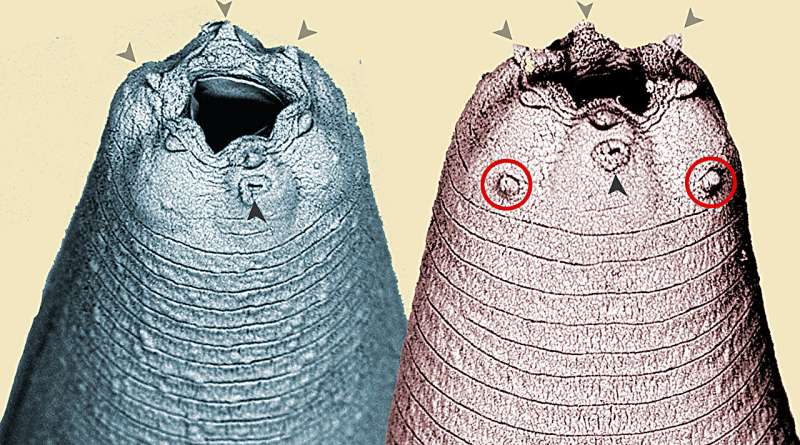This article has been reviewed according to Science X's editorial process and policies. Editors have highlighted the following attributes while ensuring the content's credibility:
fact-checked
peer-reviewed publication
trusted source
proofread
Scientists explain a glitch in the (extracellular) matrix

Through an electron microscope they may look like the giant sandworms from Dune, but C. elegans nematodes are only 1 millimeter long.
The worms have a layer that covers their bodies called the apical extracellular matrix. A similar matrix protects every surface of our own bodies, inside and out.
Anything trying to enter a C. elegans or human body—bacteria, viruses, medicines, even tastes and smells—must first cross the matrix.
By studying these worms, scientists in the lab of Harvard Medical School geneticist Max Heiman have just added to a growing body of knowledge about how the matrix is organized.
In worms, tiny openings in the matrix (arrows in photo) allow taste bud-like sensory cells to poke out into the environment. Heiman's lab focused on a set of openings that form only in adult males (circled on the worm colored in red).
Heiman's team found that a genetic switch in a single glial cell—a type of cell in the nervous system—is responsible for reorganizing the matrix to form the tiny openings.
The discovery adds to a growing body of knowledge showing that the matrix isn't a "homogeneous goop, like mucus," Heiman said, but has discrete structural features that vary during organismal development and depend on the cell types that produce it. It also provides one of the first clues about how different cell types manipulate the matrix to control access to and from their environments.

The discovery also offers clues about the possibility of designing drugs or engineering tissues to treat disease by altering matrix structure in different parts of the body—controlling what can get in, such as treatments, and what's kept out, such as bacteria and viruses.
In fact, the researchers discovered that it's not even the worm's sex that matters but the sex of the glial cell itself. By using genetic tricks to alter which sex the glial cell "thinks" it is, they could prevent the matrix openings from forming in males or cause the openings to appear in worms of the opposite sex.
Along the way, they identified some of the first genes that distinguish glial cells between the sexes. Heiman and team hope their findings will help researchers better understand how malfunctioning glia contribute to sex-based differences in human diseases, such as autism, depression, and Alzheimer's disease.
Findings are reported in Current Biology.
More information: Wendy Fung et al, A sex-specific switch in a single glial cell patterns the apical extracellular matrix, Current Biology (2023). DOI: 10.1016/j.cub.2023.08.046
Journal information: Current Biology
Provided by Harvard Medical School




















